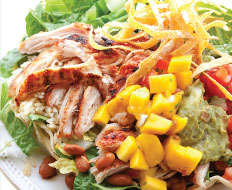A decade ago, JD and Sarah Gardner returned home to Utah from a trip to Cabo San Lucas, inspired by the surfing culture and local cuisine of the Baja Peninsula Coast. Soon after, the pair opened Costa Vida Fresh Mexican Grill.
Sean Collins and Dave Rutter—who were partners in a family entertainment center in Provo, Utah, at the time—saw the success of the original Costa Vida and became the concept’s first franchisees. Over the next four years, Costa Vida grew to 22 units, and in November 2009, Collins and Rutter bought the franchise, becoming CEO and president, respectively.
The long-time friends spent a year building the rest of their executive team and “figuring out how to build stores and make them profitable,” Collins says. Costa Vida resumed franchising in late 2010.
With 50 locations already open and operating in 10 states and Canada, and an additional 217 restaurants in various stages of development, the company plans to nearly double its North American presence in 2013. Restaurants are predominantly located in the West, but stores are under development in both Orlando and New York.
Collins says the brand’s success stems from its laid-back vibe. “We all love to go to the beach, and Costa Vida reminds people of that feeling they get at the beach,” he says.
That beach-like aura comes from surf videos playing on flat-panel TVs throughout the restaurant, as well as high-energy music and the aroma of the Baja-inspired flavors being served up.
“Costa Vida is great because of its food,” Collins says. “We have an executive chef and everything is made fresh in our restaurants every day.
“Everything is made from scratch,” he continues. “We only have two canned products in our restaurant kitchens—condensed milk and evaporated milk for making our desserts: flan, key lime pie, and tres leches cake.”
At Costa Vida, each tortilla is handmade and served hot, while sweet pork and shredded beef are slow-cooked for hours.
Costa Vida Fresh Mexican Grill
CEO: Sean Collins
HQ: Lehi, Utah
Year Started: 2003
Annual Sales: Undisclosed
Total Units: 50
Franchise units: 42
“The tortilla is made right in front of you, and then you go right down the line and see your whole meal made in front of you,” Collins says.
Some of the choices guests can make are a bit different from those at other quick-serve Mexican restaurants, he adds.
“With traditional Mexican food, the flavor profiles are a little different,” Collins says. “The focus is on fresh Mexican, and we have a few sweeter options like sweet pork and mango-pineapple salsa."
The menu features made-to-order burritos, tacos, enchiladas, quesadillas, salads, and nachos. Protein choices include sweet pork, grilled chicken, shredded beef, Raspberry Chipotle Chicken, grilled steak, and chile verde. Collins says the sweet pork is by far the most popular protein option. “People also rave about our Honey Glazed Shrimp Taco,” he says.
Entrées are served with cilantro lime rice and black or pinto beans. House-made guacamole, sauces, and salsas can be used to customize any order and include Mango Salsa, Honey Habanero Salsa, Salsa Fresca, and Pico de Gallo.
With the exception of tortillas and desserts, Costa Vida’s menu items are gluten free.
“Offering choices for those who need gluten-free foods is something we are happy to do, and we’ve gotten a lot of great response from those people,” Collins says. “That said, it’s really a very small part of our customer base.”
Providing healthy options and a wide variety of food choices brings in more customers, he says. Healthy recommendations from Costa Vida’s chef are available on the chain’s website, and a nutrition calculator provides calorie and nutrition counts for different item combinations. “We often have lines out the door at lunch and dinner because our dining frequency is two to three times a week,” Collins says. “We have a strong, loyal following because the flavor profiles of our proteins and sauces all fit together well and there are so many options.”
An average per-person ticket at Costa Vida is around $7.50. In addition to Coke products, Mexican bottled sodas are available, as well as horchata, a traditional Mexican drink made with rice and cinnamon. Collins is considering adding beer and wine at locations outside of Utah.
Costa Vida also has a catering program that Collins says accounts for almost 15 percent of sales. He would like to grow that part of the business even more.
Due to catering opportunities during lunch, Collins says he prefers units be located in areas with a high density of businesses.
“We also love being in proximity to universities and near places SUV moms frequent, like Costco or large grocery stores,” he says. “We do well in all these locations.”
A typical footprint for a Costa Vida restaurant is 3,000 square feet, and most have patio dining. To increasingly land in areas Collins and Rutter want to be, they’re focused on growing through multiunit franchisees.
A minimum development agreement of three locations is required, Collins says, and the company’s average franchise agreement to this point has been for nine stores.










